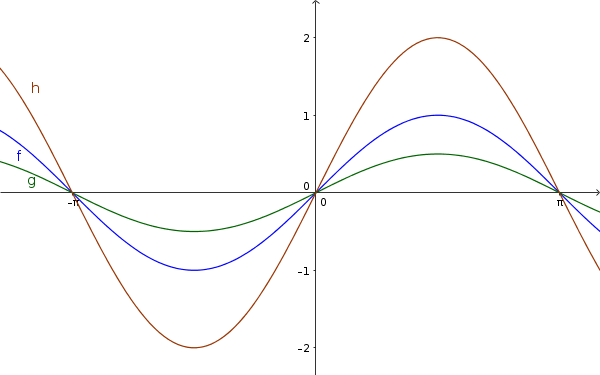Stretching and compressing
a) parallel to the y-axis:
The graphs of $y=\sin(x)$ and $y=\cos(x)$ are stretched and compressed with the factor $a$ parallel to the y-axis. This changes the amplitude. The general formula is:
$y=a\cdot\sin(x)$
$y=a\cdot\cos(x)$
$y=a\cdot\cos(x)$
!
Remember
- If $|a|$ > 1, the graph is stretched.
- If $|a|$ < 1, the graph is compressed.
- If $a$ < 0, the graph is mirrored on the x-axis
- The amplitude (maximum deflection) is $|a|$
Example
$\color{green}{g(x)=\frac12\sin(x)}$
$\color{blue}{f(x)=\sin(x)}$
$\color{brown}{h(x)=2\sin(x)}$

b) parallel to the x-axis:
The graphs of $y=\sin(x)$ and $y=\cos(x)$ are stretched or compressed with the factor $b$ parallel to the x-axis. The period changes. The general formula is:
$y=\sin(b\cdot x)$
$y=\cos(b\cdot x)$
$y=\cos(b\cdot x)$
!
Remember
- If $|b|$ > 1, the graph is compressed (the period is reduced).
- If $|b|$ < 1, the graph is stretched (the period is increased).
- If $b$ < 0, the graph is mirrored on the y-axis
- The period (repetition) is $\frac{2\pi}{|b|}$
Beispiel
$\color{green}{g(x)=\sin(\frac12x)}$
$\color{blue}{f(x)=\sin(x)}$
$\color{brown}{h(x)=\sin(2x)}$

